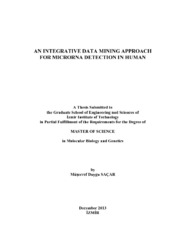Please use this identifier to cite or link to this item:
https://hdl.handle.net/11147/3678Full metadata record
| DC Field | Value | Language |
|---|---|---|
| dc.contributor.advisor | Allmer, Jens | en |
| dc.contributor.author | Saçar, Müşerref Duygu | - |
| dc.date.accessioned | 2014-07-22T13:52:08Z | - |
| dc.date.available | 2014-07-22T13:52:08Z | - |
| dc.date.issued | 2013 | en |
| dc.identifier.uri | http://hdl.handle.net/11147/3678 | - |
| dc.description | Thesis (Master)--Izmir Institute of Technology, Molecular Biology and Genetics, Izmir, 2013 | en |
| dc.description | Includes bibliographical references (leaves: 34-41) | en |
| dc.description | Text in English; Abstract: Turkish an English | en |
| dc.description | ix, 41 leaves | en |
| dc.description | Full text release delayed at author's request until 2017.01.13 | en |
| dc.description.abstract | MicroRNAs (miRNAs) are single-stranded, small, usually non-coding RNAs of about 22 nucleotides in length, that control gene expression at the posttranscriptional level through translational inhibition, degradation, adenylation, or destabilization of their target mRNAs. Although hundreds of miRNAs have been identified in various species, many more may still remain unknown. Therefore, the discovery of new miRNA genes is an important step for understanding miRNA mediated post transcriptional regulation mechanisms. First attempts for the identification of novel miRNA genes were almost exclusively based on directional cloning of endogenous small RNAs and high-throughput sequencing of large numbers of cDNA clones. However, conventional forward genetic screening is known to be biased towards abundantly and/or ubiquitously expressed miRNAs that can dominate the cloned products. Hence, such biological approaches might be limited in their ability to detect rare miRNAs, and restricted to the tissues and the developmental stage of the organism under examination. These limitations have led to the development of sophisticated computational approaches attempting to identify possible miRNAs in silico. Nevertheless, the programs designed to predict possible miRNAs in a genome are not sensitive or accurate enough to warrant sufficient confidence for validating all their predictions experimentally. With this study, we aim to solve these problems by developing a new and sensitive machine learning based approach to predict potential miRNAs in the human genome. | en |
| dc.language.iso | en | en_US |
| dc.publisher | Izmir Institute of Technology | en |
| dc.rights | info:eu-repo/semantics/openAccess | en_US |
| dc.subject.lcsh | RNA editing | en |
| dc.subject.lcsh | Small interfering RNA | en |
| dc.subject.lcsh | Data mining | en |
| dc.title | An integrative data mining approach for microRNA detection in human | en_US |
| dc.type | Master Thesis | en_US |
| dc.authorid | 0000-0003-2012-0598 | - |
| dc.institutionauthor | Saçar, Müşerref Duygu | - |
| dc.department | Thesis (Master)--İzmir Institute of Technology, Molecular Biology and Genetics | en_US |
| dc.relation.publicationcategory | Tez | en_US |
| item.fulltext | With Fulltext | - |
| item.grantfulltext | open | - |
| item.languageiso639-1 | en | - |
| item.openairecristype | http://purl.org/coar/resource_type/c_18cf | - |
| item.cerifentitytype | Publications | - |
| item.openairetype | Master Thesis | - |
| Appears in Collections: | Master Degree / Yüksek Lisans Tezleri | |
Files in This Item:
| File | Description | Size | Format | |
|---|---|---|---|---|
| 10013313.pdf | MasterThesis | 1.2 MB | Adobe PDF |  View/Open |
CORE Recommender
Page view(s)
11,342
checked on Nov 18, 2024
Download(s)
112
checked on Nov 18, 2024
Google ScholarTM
Check
Items in GCRIS Repository are protected by copyright, with all rights reserved, unless otherwise indicated.